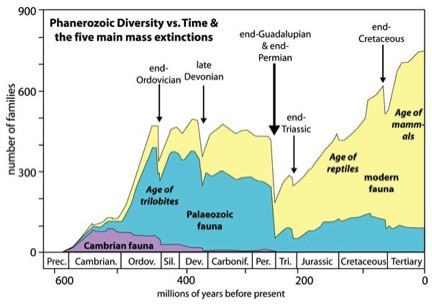When will the next mass extinction occur? - Borths, D'Emic, and Pritchard
1,701,609 Views
19,462 Questions Answered
Let’s Begin…
About 66 million years ago, a terrible extinction event wiped out the dinosaurs. But it wasn’t the only event of this kind -- extinctions of various severity have occurred throughout the Earth’s history -- and are still happening all around us today. Borths, D'Emic, and Pritchard give a quick history of mass extinctions.
Additional Resources for you to Explore
Later, in the middle of the 1800’s, Charles Darwin discovered a biological process that explained how new species arise as others go extinct. He called this process natural selection, a process that drives evolution (biological change over time). Darwin suggested changing environmental conditions selected for individuals better adapted to the new conditions. Interested in learning more about misconceptions in evolution? Try this TED Ed lesson: Myths and misconceptions about evolution.
Just as new species arise through natural selection, some species can go extinct if environmental conditions change too quickly. In the 20th century, paleontologists started tallying the number of species that were present at different points through life’s history. They noticed changes in plant and animal life punctuated the geologic record, but they also noticed five particularly dramatic extinction events when extinctions far outstripped speciation. These are the Big Five mass-extinctions, each of which had its particular severity and causes.

Today we are in the midst of a rapid extinction event that started as humans spread over the globe, bringing plants and animals from one area to another. To learn more about extinction and efforts to understand the human-driven sixth extinction there are plenty of great resources. Past Time is a paleontology podcast created by some of the educators involved in this video. Past Time is accessible to all audiences. It focuses on how scientists use new scientific tools to understand the fossil record and modern biodiversity.
For further reading for elementary school students, we highly recommend two highly visual books: T. rex and the Great Extinction by Marco Signore and Matteo Bacchin, a comic book about the last dinosaurs in North America and an educational guide to the Cretaceous Extinction. A great general guide to dinosaurs, including their extinction, is Dinosaurs: The Most Complete, Up-to-Date Encyclopedia for Dinosaur Lovers of All Ages by Thomas Holtz and Luis Rey. For any young people looking to learn about the Permian Period and the following Triassic, we highly recommend When Dinos Dawned, Mammals Munched, and Pterosaurs Took Flight by Hannah Bonner.
For further reading for older students and adults interested in the Permian Extinction, which marked the death of more than 90% of Earths’ species and the beginning of the Age of Reptiles, check out When Life Nearly Died: The Greatest Mass Extinction of All Time by Michael Benton. Dr. Benton’s book provides not only an overview of the extinction event itself but also a bit of the history of vertebrate paleontology. Another account of the Permian Extinction can be found in Extinction: How Life on Earth Nearly Ended 250 Million Years Ago by Douglas Erwin. Dr. Erwin’s book takes a closer look at how animals without backbones informed the science behind this extinction.
For information on the Cretaceous Extinction that deprived us of the dinosaurs, T. rex and the Crater of Doom is a classic science detective story by Walter Alvarez and Carl Zimmer. It tells the story of the extinction event itself and collections the evidence supporting the asteroid impact theory, which Dr. Alvarez helped discover. Another account of the Cretaceous Extinction is Night Comes to the Cretaceous: Dinosaur Extinction and the Transformation of Modern Geology by James Powell.
For a history of the extinctions of the Ice Age, we recommend Twilight of the Mammoths: Ice Age Extinctions and the Rewilding of America by Paul Martin. The idea of rewilding sound enthralling? This TED Ed lesson provides some more insight into the idea. This text presents a history of these most recent mass extinctions, in the context of the hypothesis that humans are largely responsible for the Ice Age die-offs. For a summary of extinction science and the current biodiversity crisis, we recommend The Sixth Extinction: An Unnatural History by Elizabeth Kolbert. She focuses on the scientists who are working to understand how climate change, deforestation, ocean acidification, and invasive species are changing the diversity of the world around us.
About TED-Ed Animations
TED-Ed Animations feature the words and ideas of educators brought to life by professional animators. Are you an educator or animator interested in creating a TED-Ed Animation? Nominate yourself here »
Meet The Creators
- Educator Mattew Borths, Michael D'Emic, Adam Pritchard
- Script Editor Alex Gendler
- Director Juliette Marchand
- Animator Guillaume Pallat
- Narrator Addison Anderson



